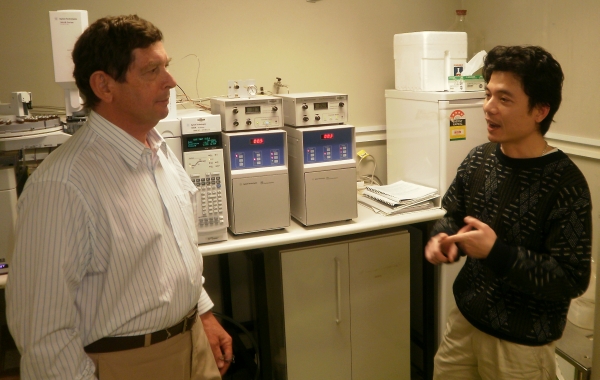Complaints due to odours are a major issue for poultry shed operators, as repeated release of unpleasant odours can constitute a public nuisance and possible regulatory violation. University of New South Wales student Mr Hung Lee, with the support of the Poultry CRC, is investigating the fate of the often overlooked volatile organo-sulphur compounds (VOSCs) in odour assessment. This is especially poignant as the potential impacts of odour emissions from intensive livestock operators on nearby communities have become a major concern to facility managers. Of particular concern to many operations is the ongoing erosion of existing buffer zones by residential encroachment.
“Generally, only hydrogen sulphide (H2S) and, in some cases, volatile organic compounds (VOCs) such as aromatic, aliphatic hydrocarbons (aldehyde, terpenes, ketones, etc.) are the main focus in odour assessment”, said Hung. “However, other odorants such as volatile organic sulphur compounds (VOSCs) such as thiols, sulphides, and disulphides are also malodorous and, in many cases, can be the dominant odorants emitted due to their very low odour thresholds”.
For odour assessment, it is important to distinguish between odorants (compounds that release odours) and odours (the perceived effects of odorants by the human olfactory system). As a result, there exist also two parallel classes of odour concentration measurements – analytical (by chemical speciation) and sensory. These two classes play an important role as the linkage that connects odorant properties and odour perception. In Australia, odour concentration measurement via dynamic olfactometry is the dominant tool for odour impact regulation, and has been standardised under an Australia/New Zealand standard (AS/NZS 4323.3:2001) .
Hung affirms, “To date however, VOSC sampling procedures are primarily based upon rules of thumb, with regard to sample storage time (up to 48 hours) and conditions; there is also a very big gap in the knowledge of the transformation, degradation and losses of VOSC odorants during sample handling, transportation and storage in the analysis chain (i.e. the fate of VOSCs)”. Thus, Hung’s research aims at addressing existing knowledge gaps with regards to the impact of environmental and temporal conditions on odorant loss and transformation/degradation. This will provide a solid, scientific basis on which to develop guidelines for sample collection, handling and storage of odorous emissions containing VOSC.
Six key parameters that have potential to influence odorant loss and degradation/transformation during sample transport and storage are under investigation, namely:
- Time
- Temperature
- Sample relative humidity
- Exposure to light (UV exposure)
- Container bag materials (Tedlar, Mylar, and Nalophan)
- The presence of other VOCs.
“Misunderstanding of experimental results can lead to the degradation/transformation products being identified as the primary nuisance, in contrast to the actual odorants present at the odorous source”, said Hung. “The results of the experimental analysis and the generation of a series of reliable methods of VOSC sample collection, storage and analysis will enable the determination of variations in VOSC composition from different poultry shed operations”.



